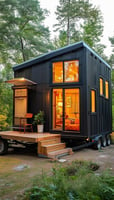In today's uncertain economic landscape, securing a stable retirement income is more critical than...
Retirees Replacement Income: Generating Rental Income through Tiny Houses Ownership
As retirees transition from full-time work to a life of leisure, one of their most pressing concerns is how to generate a sustainable replacement income. Traditional retirement savings may not always suffice, especially with increasing living costs and healthcare expenses. This challenge has led many retirees to explore alternative income sources, one of which is investing in rental properties. Among these options, tiny houses have emerged as a compelling solution.
Tiny houses offer a unique blend of affordability, sustainability, and flexibility, making them an attractive investment for retirees looking to supplement their income. In this article, we will delve into the world of tiny houses, exploring their benefits, investment potential, and practical strategies for generating rental income.
Understanding Tiny Houses
 Image Source: Fabian's story on RiceMedia
Image Source: Fabian's story on RiceMedia
What are Tiny Houses
Tiny houses are compact living spaces typically ranging from 100 to 400 square feet. They are designed to maximize efficiency and functionality while promoting a minimalist lifestyle. The tiny house movement began in the early 1970s as a response to rising housing costs and environmental concerns. Today, it has gained significant traction, with over 10,000 tiny homes reported across the United States alone.
These homes can be built on wheels for mobility or on foundations for permanent placement. The appeal of tiny houses lies not only in their size but also in their potential for sustainable living and reduced environmental impact.
Benefits of Tiny Houses
-
Lower Cost of Ownership: Tiny houses are significantly cheaper than traditional homes. The average cost of a tiny house ranges from $30,000 to $60,000 compared to the median price of a traditional home, which is over $400,000 in many areas.
-
Reduced Maintenance and Utility Expenses: Smaller spaces mean lower utility bills and maintenance costs. This financial relief can be especially beneficial for retirees on fixed incomes.
-
Eco-Friendly Living: Many tiny houses are built using sustainable materials and designed to be energy-efficient. This aligns with the growing trend towards environmentally conscious living.
- Flexibility and Mobility: Tiny houses can be relocated easily if built on wheels, allowing owners to change locations based on personal preferences or market demand.
Tiny Houses as an Investment for Retirees
Initial Investment Considerations
When considering tiny house investments, it's essential to compare costs with traditional real estate options. While building or purchasing a tiny house can be more affordable upfront, retirees should also consider additional expenses such as land acquisition or leasing costs.
Financing options for retirees may include personal loans or specialized tiny home loans. Many financial institutions now offer products tailored specifically for tiny house purchases.
Potential Rental Income
The rental market for tiny houses is growing rapidly. Depending on location and amenities, tiny homes can rent for between $800 and $1,500 per month or more in desirable areas.
Investing in a tiny house can yield impressive returns on investment (ROI). For instance, if you purchase a tiny home for $50,000 and rent it out at $1,200 per month, your annual income would be $14,400—an impressive return compared to traditional rental properties.
Legal and Zoning Considerations
Before investing in a tiny house rental, understanding local regulations is crucial. Zoning laws vary widely; some areas may restrict where tiny homes can be placed or require specific permits.
Engaging with local authorities or consulting with legal professionals can help navigate these complexities effectively.
Strategies for Success
Location Selection
Choosing the right location is vital for maximizing rental income. Urban areas with high demand for short-term rentals or scenic rural locations popular with tourists are ideal choices.
Consider factors such as proximity to attractions, accessibility to public transport, and local amenities when selecting sites for your tiny house rentals.
Marketing and Management
Effective marketing strategies are essential for attracting tenants. High-quality photographs showcasing the unique features of your tiny house can make a significant difference online.
You can rent them out year-round through platforms like Airbnb and report an annual income exceeding $10,000.
You can manage your property yourself or hire professional property management services like a hospitality agent depending on your availability and expertise in handling rentals.
Maintenance and Upkeep
Regular maintenance is crucial to keep your investment in top condition. Create a budget that accounts for ongoing maintenance costs such as repairs, cleaning services between tenants, and seasonal upkeep.
There are hospitality agents who can appoint trusted and reliable landowners to handle the maintenance and housekeeping of tiny houses. (subject to availability)
Potential Risks and Challenges
While investing in tiny houses presents numerous opportunities, there are also risks:
- Market Fluctuations: The demand for rentals can vary based on economic conditions or changing demographics within an area.
- Legal Restrictions: As mentioned earlier, zoning laws may limit where you can place your tiny home or how long you can rent it out.
To mitigate these risks, thorough research and planning are essential before making any investments.
In a Nutshell
Investing in tiny houses offers retirees an innovative way to generate replacement income while embracing a simpler lifestyle. With lower costs of ownership and the potential for significant rental income, this option is worth considering for those looking to supplement their retirement funds.
However, it's important to approach this venture with careful planning and consideration of local regulations. Tiny house ownership may not be suitable for everyone; thus, assessing personal goals and financial situations is crucial before diving into this investment strategy.
Additional Resources
What you may also want to consider to gather further information on tiny house investments:
- Websites dedicated to zoning laws specific to your area.
- Online communities focused on the tiny house movement.
- Books about sustainable living practices.
Checklist Before Investing in Tiny Houses:
- Research local zoning laws.
- Calculate potential rental income vs expenses.
- Identify prime locations.
- Develop a marketing strategy.
- Plan for maintenance costs.
FAQs
Are tiny houses legal everywhere?
No, zoning laws vary by location; it's essential to check local regulations before purchasing or renting out a tiny home.
What is the average cost of a tiny house?
Tiny houses typically range from $30,000 to $60,000 depending on size and features.
Can I finance a tiny house?
Yes! There are various financing options available specifically tailored for purchasing tiny homes.
How much can I earn renting out a tiny house?
Rental prices vary by location but typically range from $800 to over $1,500 per month depending on demand.
What are the maintenance costs associated with owning a tiny house?
Maintenance costs will depend on factors like location and condition but should be budgeted regularly just like any other property investment.
There are hospitality agents who can appoint trusted and reliable landowners to handle the maintenance and housekeeping of tiny houses. (subject to availability)
Ready to think big by investing small?
You can now be our community contributor and make a pitch to have your favourite personality be on our show.
Join our community group and drop us your insights on this topic.

-3.png?width=50&name=Square%20(2)-3.png)


